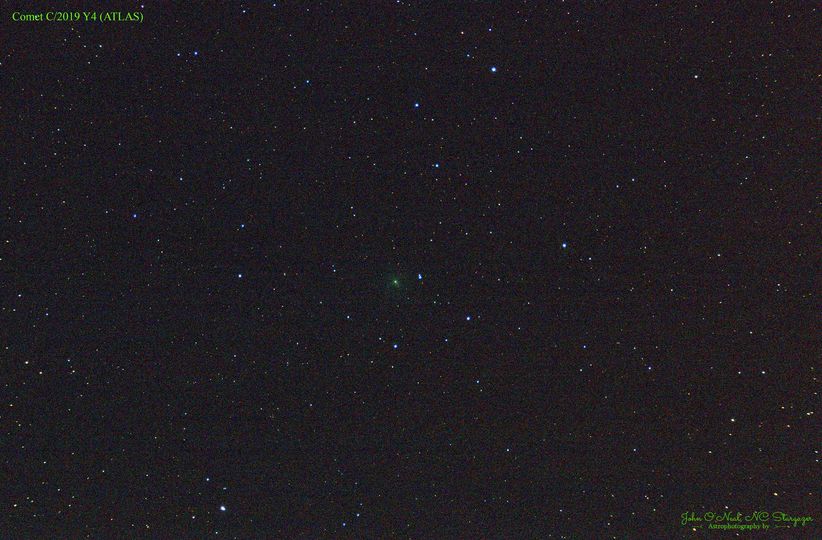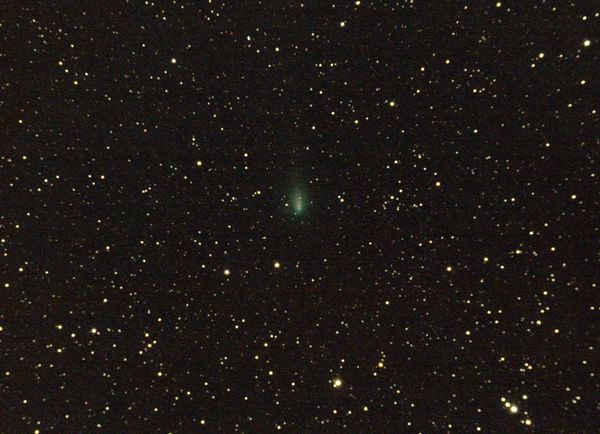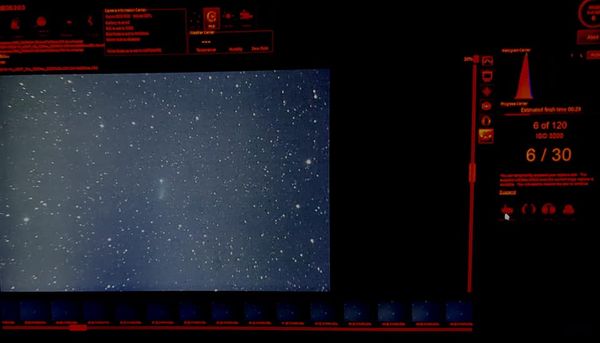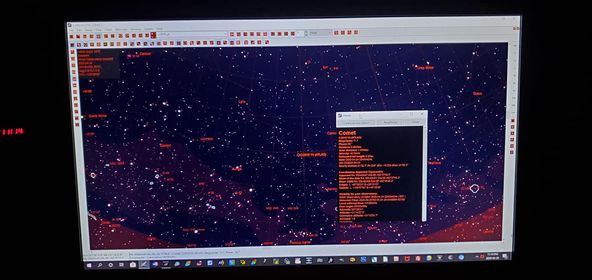Comet C/2019 Y4 (ATLAS)
For years, amateur astronomers have been waiting for a bright, naked-eye comet to pass by Earth — and finally, such an object may have arrived.
The possible celestial showpiece is known as Comet ATLAS, or C/2019 Y4.
When it was discovered on Dec. 28, 2019, it was quite faint, but since then, it has been brightening so rapidly that astronomers have high hopes for the spectacle it could put on.
But given the tricky nature of comets, skywatchers are also being cautious not to get their hopes up, knowing that the comet may fizzle out.
It's been awhile since a comet gave skywatchers a good show, particularly in the Northern Hemisphere.
In March 2013, Comet PanSTARRS was visible right after sunset, albeit low in the western sky.
But although it briefly attained first magnitude with a short, bright tail, its low altitude and a bright,
twilight sky detracted from what otherwise would have been a much more prominent object.
Below is a stack of 66 30 second subs at 1600 ISO. Orion EON ED80 & Canon 60Da. Stacked in Astro Pixel Processor
 .
.Comat Atlas, C/2019 Y4 no longer has a round coma. It elongated now and brightness is down dramatically.
Here's my shot from tonight. second is a crop.




I thought my stacking program was messed up.....
Possible Disintegration of Comet C/2019 Y4 (ATLAS)
ATel #13620; Quanzhi Ye (U. Maryland), Qicheng Zhang (Caltech)
on 6 Apr 2020; 17:12 UT
Distributed as an Instant Email Notice Comets
Credential Certification: Quanzhi Ye (qye@umd.edu)
Subjects: Optical, Comet
Referred to by ATel #: 13622
We
report the possible disintegration of comet C/2019 Y4 (ATLAS), revealed
by the public monitoring program
carried out by the 0.6-m Ningbo Education Xinjiang Telescope (NEXT).
Images taken on UT 2020 April 5.6-5.9 showed an elongated pseudo-nucleus measuring about 3 arcsec in length and aligned with the axis of the tail,
a morphology consistent with a sudden decline or cessation of dust production, as would be expected from a major disruption of the nucleus.
The elongation is grossly consistent with the roughly +5" in RA, -1" in Dec astrometric residuals currently (as of MPEC 2020-G65) being reported relative to JPL orbit solution #5,
implying a relative projected motion of order 5-10 m/s from the original nucleus' orbit.
A disruption event could also potentially explain the large non-gravitational forces acting on the comet, as reported in CBET 4744.
Composite stacks of 10 x 30-s r-filtered frames illustrating the change in morphology from April 2 to 5 can be found at https://near.earth/shared/2020/04/next_20200405.png.
(The images from both days were obtained without comet-rate tracking, but the exposure was sufficiently short that the trailing of the comet due to its non-sidereal motion is only 1.3 pixel,
much shorter than the elongation of the pseudo-nucleus. The direction of the trailing is also at a ~30 deg angle to the long-axis of the elongated pseudo-nucleus.)

carried out by the 0.6-m Ningbo Education Xinjiang Telescope (NEXT).
Images taken on UT 2020 April 5.6-5.9 showed an elongated pseudo-nucleus measuring about 3 arcsec in length and aligned with the axis of the tail,
a morphology consistent with a sudden decline or cessation of dust production, as would be expected from a major disruption of the nucleus.
The elongation is grossly consistent with the roughly +5" in RA, -1" in Dec astrometric residuals currently (as of MPEC 2020-G65) being reported relative to JPL orbit solution #5,
implying a relative projected motion of order 5-10 m/s from the original nucleus' orbit.
A disruption event could also potentially explain the large non-gravitational forces acting on the comet, as reported in CBET 4744.
Composite stacks of 10 x 30-s r-filtered frames illustrating the change in morphology from April 2 to 5 can be found at https://near.earth/shared/2020/04/next_20200405.png.
(The images from both days were obtained without comet-rate tracking, but the exposure was sufficiently short that the trailing of the comet due to its non-sidereal motion is only 1.3 pixel,
much shorter than the elongation of the pseudo-nucleus. The direction of the trailing is also at a ~30 deg angle to the long-axis of the elongated pseudo-nucleus.)

The first time was Comet McNaught. It was so bright you could see the tail on the horizon at dusk, even though the coma was below the horizon

